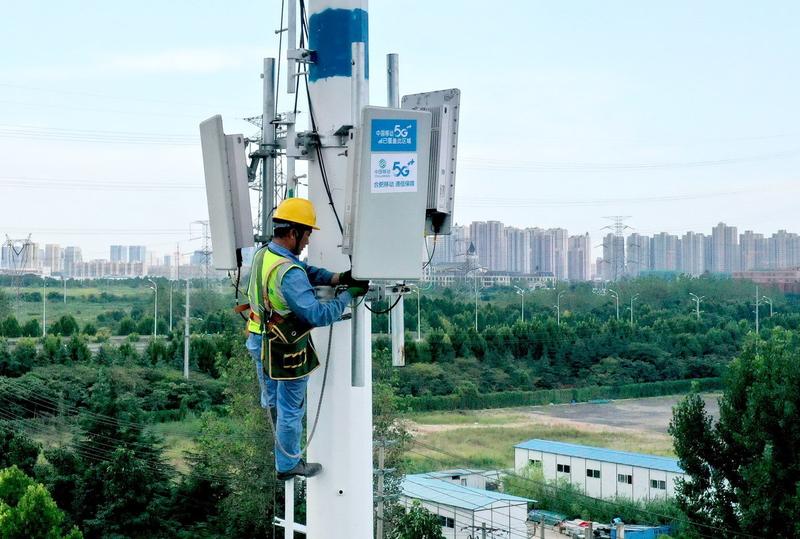 Visitors try 5G smartphones at the exhibition area of ZTE Corp during the 2020 World 5G Convention in Guangzhou, Guangdong province, on Nov 27, 2020. (LI ZHIHAO / FOR CHINA DAILY)
Visitors try 5G smartphones at the exhibition area of ZTE Corp during the 2020 World 5G Convention in Guangzhou, Guangdong province, on Nov 27, 2020. (LI ZHIHAO / FOR CHINA DAILY)
For Zhang Qiang, who runs a smartphone store in Beijing, November was a very busy month. Eight out of 10 potential customers who visited his store bought a 5G smartphone each.
"Most of them came to check out 5G handsets. Not everyone bought one, but I can see mounting enthusiasm for 5G. Days of COVID-19-related hardship may be finally making way for good days," Zhang said.
Next year will see an explosive growth of 5G smartphones. We forecast that over 350 million units of smartphones will be sold in China and 280 million units of them will be 5G handset
Jian Qin, deputy general manager of China Mobile
His optimism appears appropriate. More than 700,000 5G base stations have been built across China. They cover all prefecture-level cities. More local smartphone users are now eager to upgrade to 5G.
As of Oct 31, 124 million 5G smartphones were shipped out of factories to retailers across China. That's impressive considering that commercial 5G services were rolled out just one year back, according to the China Academy of Information and Communications Technology, a think tank affiliated with the Ministry of Industry and Information Technology.
In October alone, 5G handsets accounted for more than 64 percent of all smartphones shipped in China. Again, that represents a surge from January's 15 percent. The penetration rate is expected to hit 80 percent next year as Chinese smartphone manufacturers and telecom operators are promoting 5G. They have lowered prices of 5G devices as well as 5G data plans, company executives and industry experts said.
ALSO READ: Official: China has over 700,000 5G base stations
Expectations of faster 5G growth arose after the top leadership of the Communist Party of China called for demand-side reform earlier this month, in pursuit of the new dual-circulation development pattern that has the domestic market as the mainstay with the domestic and foreign markets boosting each other.
Zhong Zhengsheng, chief economist of Ping An Securities, said: "In the future, amid consumption upgrade and people's desire for a better life, the industrial structure in China will better adjust to the changes of consumption. This is one kind of demand-side reform we hope to see."
 In this undated photo, a maintenance worker inspects 5G tower equipment of China Mobile in Hefei, Anhui province. The company has more than 90 million 5G smartphone users as of Nov 30, 2020. (CHEN SANHU / FOR CHINA DAILY)
In this undated photo, a maintenance worker inspects 5G tower equipment of China Mobile in Hefei, Anhui province. The company has more than 90 million 5G smartphone users as of Nov 30, 2020. (CHEN SANHU / FOR CHINA DAILY)
Reform could also prove a near-to-long-term positive, if the optimism of Jian Qin, deputy general manager of China Mobile, the world's largest telecom operator by mobile subscribers, is any indication. "Next year will see an explosive growth of 5G smartphones. We forecast that over 350 million units of smartphones will be sold in China and 280 million units of them will be 5G handsets."
China Mobile has already garnered more than 90 million 5G smartphone users as of Nov 30. "Currently, every month, more than 14 million 5G smartphones are activated to connect with our telecom network. By the end of next year, the monthly figure is expected to exceed 27 million units," Jian said.
Signs of the expected boom were evident during this year's Singles Day online shopping festival, when 5G smartphones accounted for over 90 percent of the best-selling handsets sold on major e-commerce platforms
Signs of the expected boom were evident during this year's Singles Day online shopping festival that ran from Nov 1 to Nov 11, when 5G smartphones accounted for over 90 percent of the best-selling handsets sold on major e-commerce platforms.
"We think nearly 300 million users on our telecom network may upgrade to 5G. We aim to have 200 million new 5G smartphones connected to our network next year," Jian said.
READ MORE: Ministry: China 5G development showing promising results
To achieve the target, China Mobile will devote more than 20 billion yuan (US$3.06 billion) worth of resources to encourage consumers to buy 5G smartphones. And 10 billion yuan will go into research and development, and more than 10 billion yuan into marketing and partnerships.
Ma Jihua, an independent telecom analyst who has been following the industry for more than a decade, said China Mobile's every move in 5G is being closely watched by the global telecom industry.
"Such a big investment promise from China Mobile sounds like a clarion call to the nation's 5G industry. It will attract more industrial resources to the task of increasing the popularity of 5G smartphones, and will also catalyze the emergence of 5G 'killer apps'," Ma said.
Sensing the huge business opportunity, smartphone makers in China are vying to unveil high-end 5G devices with cutting-edge functions as well as budget-range handsets, so as to bring in different consumer groups into the new technology fold
Sensing the huge business opportunity, smartphone makers in China are vying to unveil high-end 5G devices with cutting-edge functions as well as budget-range handsets, so as to bring in different consumer groups into the new technology fold.
For instance, in September, Realme, a relatively new entrant to the market, unveiled a 5G phone priced under 1,000 yuan-arguably the most affordable 5G smartphone in China. It also marks Realme's aggressive push to establish a presence in the fiercely competitive 5G handset market.
Other players such as Vivo and Xiaomi have also been rapidly expanding their 5G smartphone portfolios. Their products encompass all price points to reach more customers.
READ MORE: 5G, industrial internet changing production
For its part, Oppo is running on full throttle with innovative 5G products, better corporate structure and more focused marketing strategies. Liu Bo, who took over as head of Oppo's China business in April, said all of the company's smartphones unveiled in China this year, including budget handsets, support 5G connectivity.
"We are very determined to embrace the 5G era," Liu said, adding that Oppo will take more steps in product development and marketing resources to outcompete rivals in the Chinese market.
 Visitors play 5G-based virtual reality games at the annual China Suzhou Information Technology Expo in Suzhou, Jiangsu province, on Dec 10, 2020. (ZHAI HUIYONG / FOR CHINA DAILY)
Visitors play 5G-based virtual reality games at the annual China Suzhou Information Technology Expo in Suzhou, Jiangsu province, on Dec 10, 2020. (ZHAI HUIYONG / FOR CHINA DAILY)
The company is working to attract video lovers with its latest 5G handsets that feature shake-resistant cameras and the ability to shoot videos in dark conditions.
Not to be outdone, Huawei, China's largest smartphone maker, is working hard to sustain its 5G strategy, in spite of the US restrictions that have constrained its supply chains. The company unveiled its 5G-powered Mate 40 series in late October, powered by its in-house chip Kirin 9000 series, which Huawei called "the most sophisticated 5-nanometer" 5G system on chips.
To be sure, Huawei continues to lead the 5G smartphone market in China. In the third quarter of this year, it boasted a market share of 56.6 percent, according to market research company International Data Corp.
Industry analysts forecast 2021 will likely see a further decline in 5G smartphone prices, with all devices priced above 1,000 yuan becoming 5G compatible, while more 5G handset models priced less than 1,000 yuan will be introduced
Oppo and Vivo trail Huawei with 16.2 percent and 14.5 percent market shares, respectively. They are supported mainly by their under US$300 5G products. Xiaomi ranks fourth, followed by Realme, which launched several new 5G models in September in both online and offline channels, IDC said.
Ethan Qi, senior analyst from market research company Counterpoint, said companies' efforts industrywide will likely further boost 5G smartphone sales.
In the third quarter, over 50 percent of smartphones sold in China were 5G-enabled, compared to 33 percent in the second quarter and 16 percent in the first quarter.
Apple's 5G iPhones materialized across channels in the fourth quarter, so, it would be reasonable to expect the share of 5G phones in overall smartphone sales to rise to nearly 70 percent by the end of this year, industry analysts said.
READ MORE: Competition heats up in China's 5G device market as Apple enters fray
Looking ahead, they forecast 2021 will likely see a further decline in 5G smartphone prices, with all devices priced above 1,000 yuan becoming 5G compatible, while more 5G handset models priced less than 1,000 yuan will be introduced.
Xiang Ligang, director-general of the Information Consumption Alliance, a telecom industry association, said 5G smartphones are no longer rare but more efforts are needed to come up with apps that are unique for the 5G era. 5G can be much more than just faster downloads, he said.
"5G smartphones have the potential to create new value that 4G handsets cannot deliver, and companies need to work more on that. It's not just consumers' desire but also a signal for the companies to make the most of the new-generation wireless technology," Xiang said.



